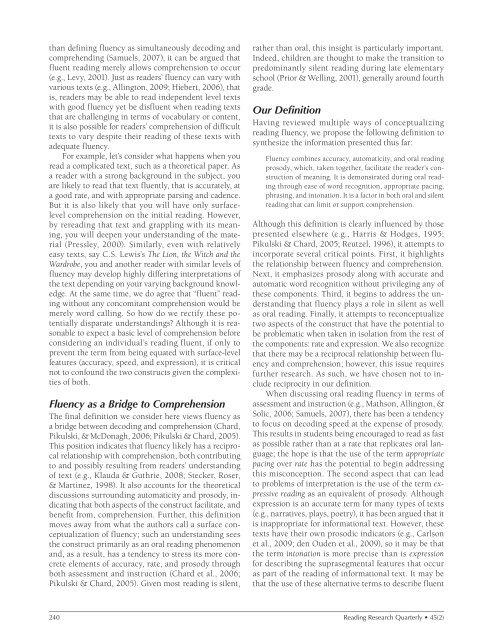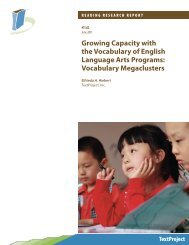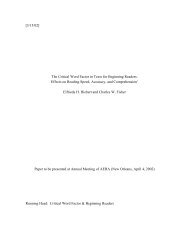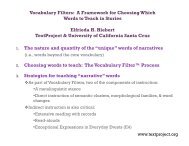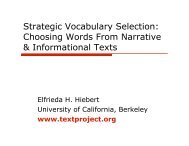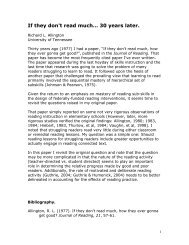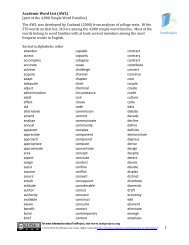Aligning Theory and Assessment of Reading Fluency - Wiley Online ...
Aligning Theory and Assessment of Reading Fluency - Wiley Online ...
Aligning Theory and Assessment of Reading Fluency - Wiley Online ...
Create successful ePaper yourself
Turn your PDF publications into a flip-book with our unique Google optimized e-Paper software.
than defining fluency as simultaneously decoding <strong>and</strong>comprehending (Samuels, 2007), it can be argued thatfluent reading merely allows comprehension to occur(e.g., Levy, 2001). Just as readers’ fluency can vary withvarious texts (e.g., Allington, 2009; Hiebert, 2006), thatis, readers may be able to read independent level textswith good fluency yet be disfluent when reading textsthat are challenging in terms <strong>of</strong> vocabulary or content,it is also possible for readers’ comprehension <strong>of</strong> difficulttexts to vary despite their reading <strong>of</strong> these texts withadequate fluency.For example, let’s consider what happens when youread a complicated text, such as a theoretical paper. Asa reader with a strong background in the subject, youare likely to read that text fluently, that is accurately, ata good rate, <strong>and</strong> with appropriate parsing <strong>and</strong> cadence.But it is also likely that you will have only surfacelevelcomprehension on the initial reading. However,by rereading that text <strong>and</strong> grappling with its meaning,you will deepen your underst<strong>and</strong>ing <strong>of</strong> the material(Pressley, 2000). Similarly, even with relativelyeasy texts, say C.S. Lewis’s The Lion, the Witch <strong>and</strong> theWardrobe, you <strong>and</strong> another reader with similar levels <strong>of</strong>fluency may develop highly differing interpretations <strong>of</strong>the text depending on your varying background knowledge.At the same time, we do agree that “fluent” readingwithout any concomitant comprehension would bemerely word calling. So how do we rectify these potentiallydisparate underst<strong>and</strong>ings? Although it is reasonableto expect a basic level <strong>of</strong> comprehension beforeconsidering an individual’s reading fluent, if only toprevent the term from being equated with surface-levelfeatures (accuracy, speed, <strong>and</strong> expression), it is criticalnot to confound the two constructs given the complexities<strong>of</strong> both.<strong>Fluency</strong> as a Bridge to ComprehensionThe final definition we consider here views fluency asa bridge between decoding <strong>and</strong> comprehension (Chard,Pikulski, & McDonagh, 2006; Pikulski & Chard, 2005).This position indicates that fluency likely has a reciprocalrelationship with comprehension, both contributingto <strong>and</strong> possibly resulting from readers’ underst<strong>and</strong>ing<strong>of</strong> text (e.g., Klauda & Guthrie, 2008; Stecker, Roser,& Martinez, 1998). It also accounts for the theoreticaldiscussions surrounding automaticity <strong>and</strong> prosody, indicatingthat both aspects <strong>of</strong> the construct facilitate, <strong>and</strong>benefit from, comprehension. Further, this definitionmoves away from what the authors call a surface conceptualization<strong>of</strong> fluency; such an underst<strong>and</strong>ing seesthe construct primarily as an oral reading phenomenon<strong>and</strong>, as a result, has a tendency to stress its more concreteelements <strong>of</strong> accuracy, rate, <strong>and</strong> prosody throughboth assessment <strong>and</strong> instruction (Chard et al., 2006;Pikulski & Chard, 2005). Given most reading is silent,rather than oral, this insight is particularly important.Indeed, children are thought to make the transition topredominantly silent reading during late elementaryschool (Prior & Welling, 2001), generally around fourthgrade.Our DefinitionHaving reviewed multiple ways <strong>of</strong> conceptualizingreading fluency, we propose the following definition tosynthesize the information presented thus far:<strong>Fluency</strong> combines accuracy, automaticity, <strong>and</strong> oral readingprosody, which, taken together, facilitate the reader’s construction<strong>of</strong> meaning. It is demonstrated during oral readingthrough ease <strong>of</strong> word recognition, appropriate pacing,phrasing, <strong>and</strong> intonation. It is a factor in both oral <strong>and</strong> silentreading that can limit or support comprehension.Although this definition is clearly influenced by thosepresented elsewhere (e.g., Harris & Hodges, 1995;Pikulski & Chard, 2005; Reutzel, 1996), it attempts toincorporate several critical points. First, it highlightsthe relationship between fluency <strong>and</strong> comprehension.Next, it emphasizes prosody along with accurate <strong>and</strong>automatic word recognition without privileging any <strong>of</strong>these components. Third, it begins to address the underst<strong>and</strong>ingthat fluency plays a role in silent as wellas oral reading. Finally, it attempts to reconceptualizetwo aspects <strong>of</strong> the construct that have the potential tobe problematic when taken in isolation from the rest <strong>of</strong>the components: rate <strong>and</strong> expression. We also recognizethat there may be a reciprocal relationship between fluency<strong>and</strong> comprehension; however, this issue requiresfurther research. As such, we have chosen not to includereciprocity in our definition.When discussing oral reading fluency in terms <strong>of</strong>assessment <strong>and</strong> instruction (e.g., Mathson, Allington, &Solic, 2006; Samuels, 2007), there has been a tendencyto focus on decoding speed at the expense <strong>of</strong> prosody.This results in students being encouraged to read as fastas possible rather than at a rate that replicates oral language;the hope is that the use <strong>of</strong> the term appropriatepacing over rate has the potential to begin addressingthis misconception. The second aspect that can leadto problems <strong>of</strong> interpretation is the use <strong>of</strong> the term expressivereading as an equivalent <strong>of</strong> prosody. Althoughexpression is an accurate term for many types <strong>of</strong> texts(e.g., narratives, plays, poetry), it has been argued that itis inappropriate for informational text. However, thesetexts have their own prosodic indicators (e.g., Carlsonet al., 2009; den Ouden et al., 2009), so it may be thatthe term intonation is more precise than is expressionfor describing the suprasegmental features that occuras part <strong>of</strong> the reading <strong>of</strong> informational text. It may bethat the use <strong>of</strong> these alternative terms to describe fluent240<strong>Reading</strong> Research Quarterly • 45(2)


